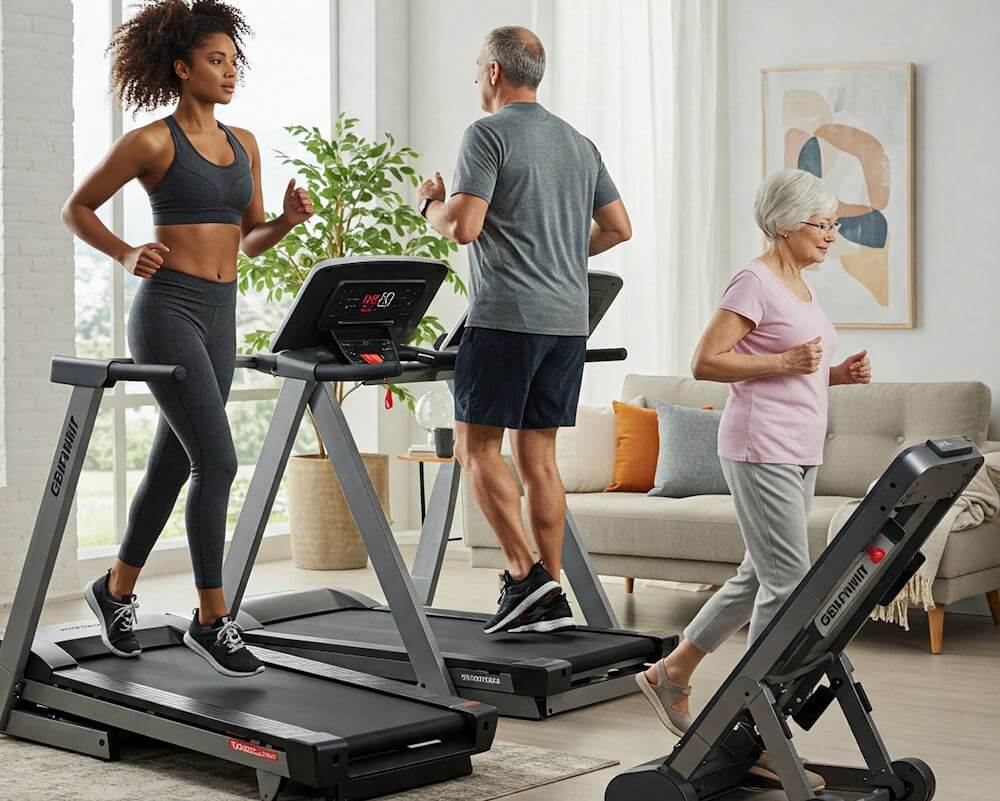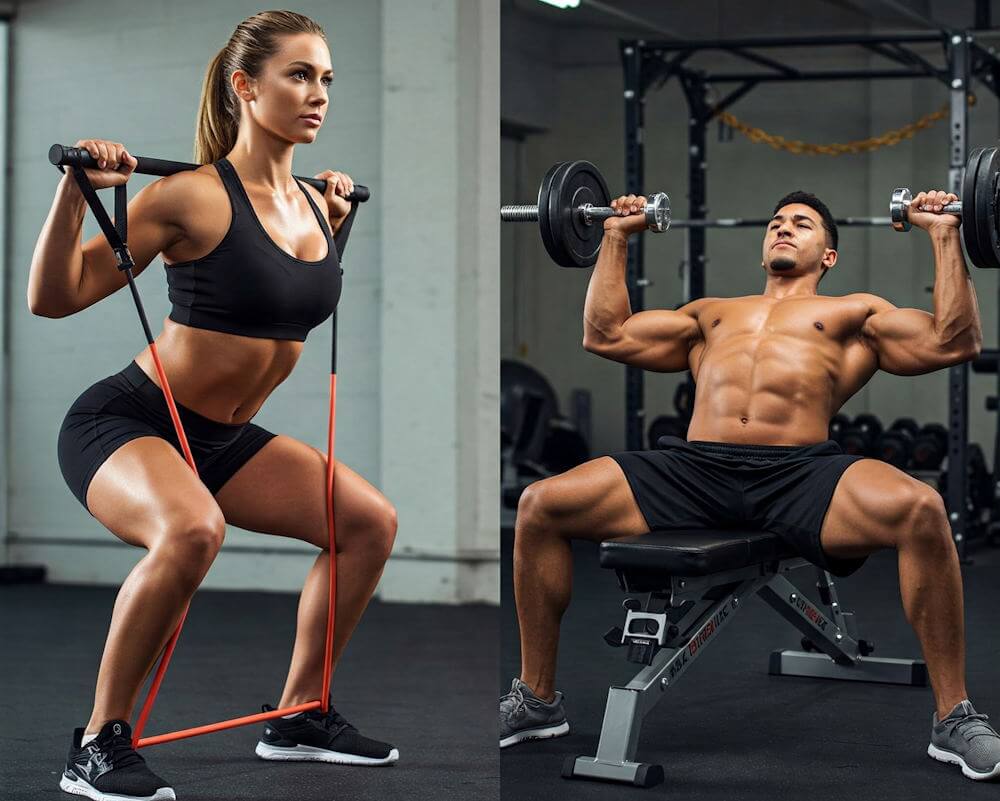Understanding Your Fitness Goals
Before investing in a treadmill, it is crucial to have a clear understanding of your fitness goals. Treadmills are versatile machines that cater to various training objectives, and identifying your specific aims will help you select the right model and features to meet those needs. Common fitness goals include weight loss, endurance training, rehabilitation, and performance enhancement.
For individuals focused on weight loss, a treadmill that offers high-intensity interval training (HIIT) options or customizable incline settings can enhance calorie burn. Higher incline levels increase the intensity of workouts, enabling individuals to achieve their weight loss goals more effectively. Additionally, monitoring heart rate during workouts can assist in maintaining optimal effort levels for fat burning.
On the other hand, those whose primary goal is endurance training should look for treadmills that feature longer workout programs and the ability to sustain lower-impact running over extended periods. These treadmills often provide features such as preset training regimens that gradually increase in intensity or duration, which can help build stamina over time. Furthermore, a quality treadmill with a sturdy frame and plush cushioning can support extended training sessions while reducing the risk of injury.
Individuals recovering from injuries may want a treadmill that includes features designed to accommodate rehabilitation. These may include customizable speed settings that allow for gradual progression or low-impact running options that minimize stress on the joints. Additionally, some machines offer monitoring features to track heart rate and perceived exertion, which can be beneficial for rehabilitation activities.
Lastly, for those aiming for performance enhancement, such as training for races, selecting a treadmill that mimics outdoor conditions will be essential. Features like adjustable incline and advanced tracking capabilities will aid in simulating the various terrains encountered during outdoor running. By clearly defining your fitness goals, you are more likely to find the treadmill best suited to achieving your aspirations efficiently and effectively.
Types of Treadmills
When considering the purchase of a treadmill, understanding the various types available is crucial to finding one that aligns with your fitness goals and lifestyle. The primary types of treadmills are manual, motorized, and commercial, each offering distinct advantages and disadvantages.
Manual treadmills, which rely on the user’s leg power to move the belt, are often more budget-friendly and portable. They provide a simple and effective means of exercise, ideal for individuals who prefer a straightforward workout without the technological complexities of motorized options. However, the intensity of the workout is entirely dependent on the user’s effort, and they tend to have limited features such as incline options or preset workouts, making them less versatile for various training regimens.
Motorized treadmills, on the other hand, are equipped with an electric motor that powers the moving belt. This type usually comes with more advanced features, such as variable speed settings, incline adjustments, and integrated workout programs. These features cater to a broader range of users, from beginners to experienced athletes looking for specific training challenges. While these treadmills often provide a more comfortable exercise experience, they generally require a higher investment and can take up more space in the home.
Lastly, commercial treadmills are designed for high-frequency use and are often found in gyms and fitness clubs. These models are built with superior durability, advanced technology, and enhanced features that appeal to serious fitness enthusiasts. However, their price points tend to be significantly higher, making them less accessible for individual consumers who may not require the same level of robustness.
Choosing the right type of treadmill ultimately hinges on your personal fitness objectives, budget constraints, and space considerations. Evaluating these factors will help you determine which treadmill best meets your needs.
Key Features to Consider
Selecting the appropriate treadmill for your fitness goals requires careful consideration of several key features. One of the foremost aspects to evaluate is motor power, typically measured in continuous duty horsepower (CHP). A treadmill with a higher CHP rating tends to be more durable and provides a smoother running experience, particularly useful for those who plan on using it for high-intensity workouts or longer durations.
Another important feature to consider is the incline options available. Treadmills that include adjustable incline settings allow users to simulate outdoor running conditions, offering varied workouts that can enhance cardiovascular endurance and target different muscle groups. For individuals aiming to build strength or challenge themselves further, the ability to incline can significantly add value to their workout sessions.
The running surface area is also critical, as an adequately sized deck ensures comfort while exercising. A more spacious surface caters to different stride lengths and running styles, reducing the risk of injury. Typical dimensions for a comfortable running surface range around 55 to 60 inches in length and at least 20 inches in width.
Cushioning systems developed in modern treadmills can enhance the exercise experience by providing support to joints and minimizing impact. This is particularly beneficial for those recovering from injuries or who experience discomfort while running. Choosing a treadmill with adjustable cushioning systems can be an advantageous feature.
Lastly, onboard technology such as display screens and workout programs enhances user engagement. Consider treadmills that offer variety in their preset workouts, heart rate monitoring, and connectivity options to fitness apps. These features not only make workouts more enjoyable but also help track progress towards fitness goals.
Budgeting for Your Treadmill
When it comes to investing in a treadmill, potential buyers should consider a variety of price ranges that cater to different fitness needs and budgets. The cost of a treadmill can range significantly, from economical models priced at around $200 to high-end commercial-grade options exceeding $4,000. Understanding your personal fitness goals and how often you plan to utilize the treadmill will help in determining a suitable budget.
For those new to fitness or with occasional use in mind, a budget-friendly treadmill in the $200 to $600 range is often appropriate. These models typically feature essential functions such as basic displays for tracking time, distance, and calories burned. While they may lack advanced cushioning or motor power, they serve well for light walking and jogging. Those who intend to use the treadmill consistently should consider stepping up their budget to the $600-$1,200 range. This price point generally includes more robust motors, additional workout programs, and enhanced durability, making them suitable for regular running sessions.
For serious fitness enthusiasts or those who are training for specific goals, investing between $1,200 and $2,500 is advisable. Treadmills in this category often boast higher incline ranges, advanced workout tracking technology, and superior shock absorption systems. Additionally, they may come equipped with interactive features such as subscription services or built-in virtual training sessions, enhancing the workout experience. For individuals or gyms seeking commercial-grade equipment, the $2,500 – $4,000 range will likely be appropriate. Such treadmills are designed for heavy usage and come with extended warranties and advanced features that cater to professional training environments.
In essence, setting a realistic budget that aligns with your fitness needs will guide you to the right treadmill choice, ensuring that you invest wisely without compromising on your commitment to your health and fitness aspirations.
Space Considerations
Choosing the right treadmill for your fitness goals goes beyond just the machine’s features and specifications; it is crucial to take into account the available space in your home or gym. The placement of a treadmill significantly affects its usability, and several factors must be considered to ensure that you select a treadmill that fits comfortably within your environment.
First and foremost, measuring the space where you intend to place the treadmill is essential. Start by determining the length and width of the area, allowing additional space for safe access and ventilation. Most treadmills require a minimum of 2-3 feet of clearance on each side, as well as adequate room behind the unit for safety. Additionally, the ceiling height should be considered. Those who are taller or prefer to run at higher speeds may need extra vertical space to avoid any potential collisions.
Flooring is another critical factor. Treadmills are heavy machines that can cause damage to certain types of flooring over time. If your home has carpet, consider placing a protective mat underneath the treadmill to provide stability and prevent wear. Conversely, if you have hardwood floors, using the appropriate mat can help absorb shock and keep the machine in place. Accessibility is also vital to ensuring that you can use the treadmill comfortably; be sure to opt for a location that allows for easy entry and exit from both sides of the treadmill.
For those restricted by limited space, consider looking into foldable treadmills. These models are designed to be compact and can be easily stored away when not in use. Such space-saving options are ideal for homes with smaller dedicated workout areas, allowing users to maintain their fitness routines without sacrificing room for other activities.
User Reviews and Brand Reputation
When selecting a treadmill, researching user reviews and understanding brand reputation is crucial for making an informed decision. User feedback often provides insights into the product’s performance, durability, and overall satisfaction, which can better inform your choice in relation to your fitness goals. Multiple platforms offer reviews, including manufacturers’ websites, independent review sites, and fitness forums. Engaging with these platforms will give you a well-rounded perspective on various options available in the market.
While examining customer reviews, focus on aspects such as the treadmill’s features, ease of use, and the customer service experience. Look for recurring themes in the feedback; for instance, if multiple users mention that a specific model is reliable but has a noisy motor, it indicates an area of concern. Quality of build can be assessed through durability ratings, as user experiences with long-term use can highlight whether a treadmill can withstand daily workouts and heavy usage. This analysis is essential when determining which treadmill will best suit your particular fitness regimen.
In addition, consider the reputation of the brands you are evaluating. Established brands like NordicTrack, ProForm, and Sole are often recognized for their reliability and consistent customer satisfaction. Brand reputation can greatly influence the quality of the product and the level of support you will receive post-purchase. Furthermore, newer companies may offer innovative features and competitive pricing, but investigating their user reviews is paramount to gauge their reliability.
Utilizing user reviews and researching brand reputation not only aids in identifying quality treadmills but also helps in avoiding poor investments. By leveraging this information effectively, you can choose a treadmill that aligns with your fitness goals, supporting your journey towards better health.
Testing Before You Buy
When considering the purchase of a treadmill, testing the machine before finalizing your decision is paramount. This hands-on experience allows you to assess various aspects such as comfort, usability, and functionality, ensuring that the treadmill aligns with your fitness goals. Visiting a retailer or trying out a friend’s treadmill can provide invaluable insights into what the equipment will feel like in a real workout scenario.
First and foremost, comfort is key. Pay attention to the treadmill’s running surface and suspension system. A cushioned deck can significantly reduce joint impact, which is crucial for those who might experience discomfort during high-impact activities. Ask yourself if the treadmill feels stable and secure while you walk or run. Furthermore, assess the size of the running surface; taller or longer individuals may require a larger deck to accommodate their stride without feeling constrained.
Usability is another significant factor to consider. Examine the console layout and ease of access to controls. Are the buttons intuitive and straightforward to operate? Look for features such as adjustable incline settings and pre-set workout programs that fit your fitness routine. Understanding these operational aspects can enhance your overall experience and help you stick to your fitness objectives.
Lastly, functionality cannot be overlooked. During your trial run, consider testing different speed settings to gauge the responsiveness of the machine. Is it smooth during transitions, or does it feel jerky? Additionally, examine any built-in technology such as heart rate monitors or connectivity features that can enhance your workouts and keep you engaged. By thoroughly testing these elements, you can ensure that your treadmill choice will meet your unique fitness needs effectively.
Warranty and Customer Support
When investing in a treadmill, understanding the warranty and customer support options is crucial for making a sound choice. A comprehensive warranty not only protects your investment, ensuring that manufacturing defects or mechanical failures are addressed promptly, but it also reflects the manufacturer’s confidence in their product’s quality. Typically, warranties vary in coverage; thus, it is advisable to seek out models that offer a minimum of five years for the frame and motor, and at least two years for parts and labor. This level of coverage can provide peace of mind, allowing users to focus on their fitness goals without worrying about unexpected repair costs.
Additionally, consider the terms of the warranty. Some brands may impose specific conditions, such as requiring regular maintenance or limiting the warranty based on usage frequency. Therefore, carefully review these stipulations to avoid any surprises in the event you need to utilize the warranty. The availability of extended warranty options is another factor to evaluate, as it can further enhance protection, particularly for heavy users or those seeking advanced treadmill features.
Equally important is customer support, which establishes a direct line of communication for troubleshooting or service inquiries. It is beneficial to research the manufacturer’s customer service reputation, as responsive and knowledgeable support can significantly influence your overall satisfaction with the treadmill. Look for brands that offer multiple channels of communication, including telephone support, email, and live chat. Reviews and testimonials can provide insight into how effectively a company resolves issues and assists customers after the sale. By choosing a treadmill with robust warranty coverage and strong customer support, you are more likely to achieve long-term satisfaction with your fitness equipment.
Making Your Final Decision
As you approach the final stages of selecting the right treadmill for your fitness goals, it is essential to consolidate the information you have gathered. This process involves carefully weighing various factors to ensure that the treadmill you choose aligns with your specific needs and budget. To facilitate this decision-making process, we have provided a checklist that can guide you through the final considerations.
Firstly, clarify your primary fitness goals. Are you aiming for weight loss, endurance training, or perhaps rehabilitation? Identifying your main objectives will help narrow down the features that are crucial for your specific requirements. Next, evaluate the available space in your home. Consider measurements and the treadmill’s footprint to ensure it fits comfortably in your designated area. Portability may also be a factor if you require a foldable treadmill.
Budgeting is another critical component. Determine how much you are willing to spend and whether there are financing options available. Remember that investing in a quality treadmill often pays off in terms of durability and the potential for greater workout consistency. Assess additional costs, such as maintenance, warranty options, and potential replacement parts.
Next, reflect on the features that matter most to you. Do you prioritize advanced technology like interactive screens and preset workout programs, or do simpler options suffice? Consider your comfort with the treadmill’s size and design; some users may prefer a larger running surface for an enhanced experience, while others may prioritize a more compact machine.
Finally, having completed this checklist, compile your findings and weigh the pros and cons of each option. Evaluate each treadmill against your fitness goals, capabilities, and budget constraints. This systematic approach ensures that your final decision will not only meet your immediate needs but will also be a sustainable addition to your fitness journey. With careful consideration, you can confidently choose a treadmill that will enhance your overall health and fitness experience.



